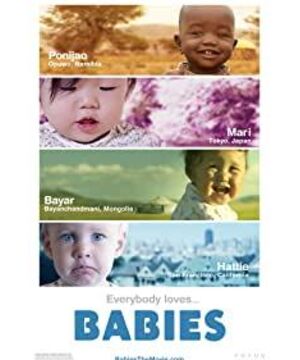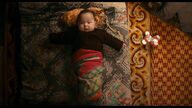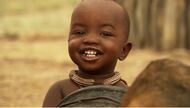The most innocent and likable group in the world are babies. They were new to the world and looked at the world with their immature eyes that were not yet fully developed. Watching them grow up is the most amazing thing. There is such a documentary, focusing on the little babies of different races around the world, I believe you will have a mother-like smile on your face when you look at it.
The film is 79 minutes long, and mainly selects several babies from Africa, Japan, Mongolia, and the United States. In chronological order, from when they were born until they were able to stand up and walk. At the beginning, there was a baby who had just emerged from the mother's belly. The umbilical cord had not been cut, and the whole body was slippery, still maintaining the position in the womb. The nurse carefully wrapped him in a quilt and placed him on the scale. Then put him with his mother again, like a little fat bug.
In Japan, American babies are taken care of right after they are born. A Japanese dad is still talking on the phone while teasing the baby with a toy. And the picture of the mother holding the child sleeping on the bed is really an indescribable beauty.
Compared with other countries, the style of African babies is much rougher. Many babies are naked and crawling around on the muddy ground. Their chocolate complexion blends in with the earth. Some babies are covered in dirt, while others grab mud from the ground and stuff it into their mouths. African mothers are really stocking their children and use the ground as a bed. Because of the cross editing of the film, the growth environment of African babies and other babies is in sharp contrast. But all these babies have one thing in common: bright, innocent eyes.
Slowly, the protagonist of the film grew to over a year old, and parents began to take their children to morning classes. At this time, babies have the most primitive desire to imitate. They dance with their hands and feet on the ground. There is also a Japanese baby who was so angry that he rolled around on the ground because he did not play well with toys, and cried sadly. It's the cutest part of the whole movie. The biggest difference between babies and us is that they don't hide their feelings, they laugh when they are happy, cry when they are sad, and never hide their feelings.
There is no narration in this film, and the language of the shots is also very restrained. Most of the shots are fixed shots, and the camera is left in place to shoot quietly. The audience can watch the babies unaffected, and they are naturally brought into it. Many of the shots are tens of seconds long, but I don't feel bored at all, because the babies are so cute! The director also gave a lot of close-ups, aiming the camera at the sleeping child's face. There was a baby who was still laughing while sleeping. Animals are also featured very well. There are roosters, puppies, cats, sheep. There is a baby who keeps touching the head of a cat, but the cat is not impatient and has been quietly accompanying the little owner, so there are many pictures of animals and the baby living in harmony.
As we all know, the aging of Japanese society is very serious, and the birth population is gradually shrinking. There is a scene in the film where more than a dozen mothers are walking on the grass with baby strollers, and all their babies are lying in the cars. Such scenes are rare in Japan, and I saw "hope" in this shot. Children are the future of society, and the director's intentions can also be seen from here.
Towards the end, the babies began to learn to walk, some fell and dawdled on the ground for a long time and couldn't get up, and some stumbled and moved their legs forward step by step. At this time, the background music faded in, and it was very soothing at first. Later, the Mongolian baby was the only one who didn't stand up. The last shot was on the grass. The director used an overhead shot. This is also the only overhead shot in the whole film. The background music is also slowly advancing. When the child finally stands up, the music reaches its climax, and the mood of the whole film also reaches its peak. Coupled with the Mongolian grassland and blue sky, the baby has a feeling of being in the sky. The whole movie is over. What I see here is "growth".
Each of us is a unique individual in the world, but we all go through the process of learning to speak and learning to walk. Why does watching this film resonate? This film is like a mirror, we see ourselves in the past from the baby.
View more about Babies reviews








